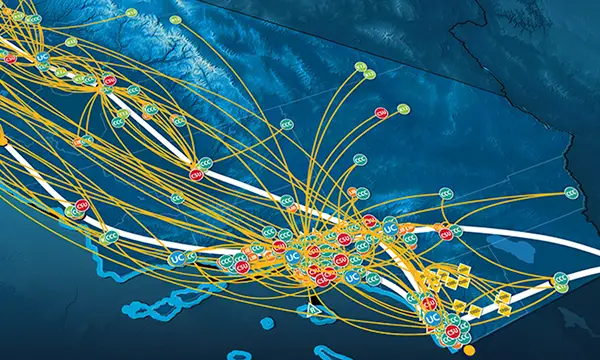- About
- Network
- Community
- Initiatives
- News
- Events
- Blog
- Publications

The Growing Contributions of Women in Computer Networking
Categories RENS & NRENS
Studies have found that men tend to drastically outnumber women at technology conferences, limiting female viewpoints, minimizing women’s contributions to leadership, and exhibiting fewer female role models. At CENIC’s 2020 Conference: The Right Connection, more than one-third of the speakers will be female.
Diversity is good for technology, and CENIC is committed to supporting programs that increase diversity, inclusion, and equity for underrepresented populations in the field of computer networking. Fixing the leaky talent pipeline in the technology industry requires strategic efforts to plug the leaks in technology career pathways, from kindergarten to college to the technology workforce. CENIC community members offer several programs for underrepresented populations to network, gain unique training, and participate in professional development opportunities — and many efforts are producing positive results.
WINS Pays Dividends
One program increasing diversity is Women in IT Networking at SuperComputing (WINS). WINS selects and awards funding to women IT professionals to help build and operate SCinet, the dedicated high-capacity network that supports revolutionary applications and some of the world’s most advanced supercomputing experiments at the annual Supercomputing Conference. At the 2019 conference, for example, Internet2 delivered the world’s longest research and education 400 gigabit Ethernet link between Chicago and Denver.
For its work, WINS was honored with the Readers' Choice Award for Workforce Diversity Leadership in the annual HPCwire Readers' and Editors' Choice Awards. WINS is a collaboration between the University Corporation for Atmospheric Research, the Department of Energy’s Energy Sciences Network, and the Keystone Initiative for Network-Based Education and Research. Two CENIC network engineers, Sana Bellamine and Julia Staats, have won past WINS recognition. CENIC has also presented WINS with an Innovation in Networking Award.
“Since WINS began in 2015, we have seen an increase in SCinet female participation from 13% to 26%. Many of the initial participants now hold leadership roles within SCinet, considered the fastest network in the world,” said Marla Meehl, WINS principal investigator from the University Corporation for Atmospheric Research and head of the Computational and Information Systems Laboratory’s Network Engineering and Telecommunications Section.
But Entrenched Bias Requires New Efforts
Similarly, the University of California’s Women in Tech Committee (UC WIT), led by the UC Office of the President’s Information Technology Services, has begun a webinar series for women to connect and share resources. UC Merced Chief Information Officer Ann Kovalchick kicked off the series with her presentation, “The First Woman Man: Gender Labels and Workplace Expectations,” to an audience of over 200 in November. Kovalchick, who will also speak at CENIC’s 2020 conference on a different topic, presented a stunning array of facts, figures, and vignettes during the webinar to expose the structural challenges for women in the workplace. Here is just a sampling:
- Women earn 80-85% of what men earn, according to the US Bureau of Labor Statistics.
- Women leave engineering careers citing negative workplace experiences as the most significant reason, according to Harvard Business Review.
- Women volunteer at much higher rates than men for non-promotable tasks, according to HBR.
- Women have about half the followers as men on Twitter, according to a study published in JAMA Internal Medicine.
- Women have a much greater chance than men of being severely injured in a car crash, due to crash test dummies anatomically designed well below the average female size, according to Consumer Reports.

Source: US Bureau of Labor Statistics, 2017.
“These problems of inequality are systemic, particularly within the tech industry,” Kovalchick said. “We all have to consider how and when we are complicit and be sure to take action because taking action is what’s going to make a difference.” Watch the webinar to learn more, including Kovalchick’s recommendations for what both women and male allies can do to push back on the structural barriers women face. Sign up to participate in future webinars.
With thousands of technology jobs left unfilled, computer networking is a field that can’t afford to leave anyone behind. CENIC supports creative approaches to increasing the number of network engineers by developing the capabilities of underrepresented female and minority engineers.
Related Content
- UC Riverside: The Growing Presence of Women in Engineering
- UCLA: Cracking the Code: Why Aren’t More Women Majoring in Computer Science?
- CSU Long Beach: Explore CSR Introduces Female Students to the World of Computer Science
- Computer Science Now a Top Major for Women at Stanford University
- The Chronicle of Higher Education: Three Ways to Get More Women into Tech
- How To Improve D&I Practices: Grace Hopper, Burning Man, and Choices
Related blog posts
The Big Game Is Big Data: How CENIC and the California Research and Education Network Support Member Athletics
When Fresno State needed to connect to Pac-12 Enterprises to broadcast a live football game over CBS, the Chancellor's Office reached out to CENIC for what Pac-12 later called the smoothest turn-up they've ever experienced.
Enabling Network-Based Collaboration Around the World: A Tour of CENIC and Partner Network Maps
On the Network Maps page at the CENIC website, you’ll find maps of all the networks, peering facilities, and exchanges to which CalREN connects, showing how thousands of CENIC member institutions connect to CalREN and to colleagues all over the globe.


